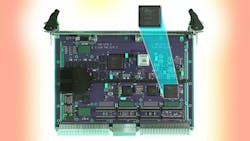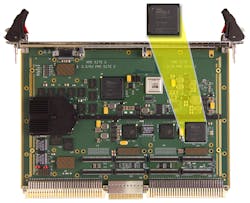VME Interfaces Return to FPGAs
This file type includes high-resolution graphics and schematics when applicable.
In the 40 years of the VME interface’s existence, board designers have implemented it on rugged embedded modules in a variety of ways. Recently, the leading approach has come nearly full circle, returning to FPGA-based interfaces, one of the earliest methods.
Originally handled with discrete components, the VME interface moved to FPGAs to reduce board real-estate usage and increase performance and features. FPGA implementations then migrated into integrated devices, such as Tundra/IDT’s Universe, Universe II, and more recently, the Tempe device. Now, following the announcement in 2014 that the popular Tempe Tsi148 VMEbus bridge chip was being end-of-life’d (EOL), many leading COTS vendors have returned to the FPGA approach.
Companies such as IOxOS Technologies are offering FPGA-based PCI Express-to-VME64x bridge devices. IOxOS’s ALTHEA 7910 VME interface, for example, is implemented in a low-cost, power-efficient Xilinx Artix-7. The re-emergence of FPGA-based bus interfaces means that legacy VME systems will continue to be supported for decades to come in the embedded commercial, military, and aerospace markets, where they have been most widely embraced.
For customers locked into VME boards that use the existing IDT Tempe chip and can’t perform a technology insertion, some COTS vendors have secured large quantities of the device. Thus, they can offer Longevity of Supply and Longevity of Repair services that ensure a customer’s existing Tempe-based boards will continue to be manufacturable for many more years.
VME Remains Vital
While newer alternative technologies like VPX have emerged that use the same form factor as VME, not every customer requires their increased performance and faster backplane data transfers. System designers will continue to build VME systems, because for many applications, its performance and affordability hits the sweet spot.
Over the last 40 years, thousands of systems and hundreds of thousands of VME cards have been shipped and deployed, many of which are still in service. Where the VME-based system is doing its job and doesn’t require significant changes, the need for VME cards will continue long into the future.
As VME evolved, more features, sophistication, bus speed, and functionality were added into the interface. This improved the overall performance of the interface on the backplane, greatly boosting transfer speeds between cards.
Today, with the demise of the popular Tempe interface, COTS manufacturers have once again turned to FPGAs for the functionality offered by the Tempe, and, more importantly, for longevity. In the intervening years since they were last used to implement the VME interface, FPGAs have significantly improved, with a greater number of gates, less power, and more functionality. Even better, the cost of using FPGAs has dropped.
FPGAs: Life Extension for VME
As leading COTS vendors change direction and return to implementing their VME interfaces in FPGAs, the result is life extension for the venerable bus architecture, ensuring that the VMEbus will remain viable for decades to come. VME will thrive as a parallel and alternative architecture to VPX, which compared to VME, tends to be higher cost, due to the higher speed requirement of its connectors.
Customers who need higher-speed interfaces and/or clocks, and require high-speed fabrics to facilitate fast data transfers between cards will move to VPX. But in VME’s favor, many opportunities remain in which VME provides the right technical solution at an affordable price, ensuring that VME has a healthy niche to thrive in.
Implementing an FPGA VME Interface
One example of an FPGA-based VME interface alternative is Curtiss-Wright’s Helix, a field-tested and proven PCI Express-to-VME64x transparent bridge that provides a full VME64xMaster/Slave interface with a direct bridge to a PCI Express upstream port (see figure). It supports advanced VME64x data-transport modes, namely 2eVME and 2eSST. The device’s dual-channel intelligent direct-memory-access (DMA) controller supports simultaneous read/write transactions exceeding 1600-MB/s data rates with PCI Express Gen2.
Because Helix can continue to be supplied for years to come, it effectively mitigates customer and system integrators concerns about obsolescence in the future. It also enables them to continue support and supply VME systems as long as required by their programs.
Helix is being used on all new Curtiss-Wright VME board designs, including the recently announced SVME/DMV-196 single board computer (SBC), which is powered by NXP’s QorIQ Power Architecture (PA) T2080 processor. Designed for technology insertions, this completely new VME board is fully pin- and feature-compatible with previous generations of Curtiss-Wright’s VME SBCs. It also delivers higher performance (>2 to 6X) in a similar power envelope and at a much lower price point compared to earlier single- and dual-processor PA VME SBC designs. Further helping to mitigate obsolescence is the T2080 processor’s 15-year lifecycle supported by NXP.
Looking for parts? Go to SourceESB.
This file type includes high-resolution graphics and schematics when applicable.
About the Author
Michael Slonosky
Senior Product Marketing Manager, Power Architecture SBCs
Michael Slonosky is the Product Marketing Manager for Power Architecture Single Board Computers in the C4 Solutions group at Curtiss-Wright. He has been with Curtiss-Wright for 14 years after spending over 20 years in the telecom industry. Mike is a graduate of the University Of Manitoba with a Master’s of Science in electrical engineering.



